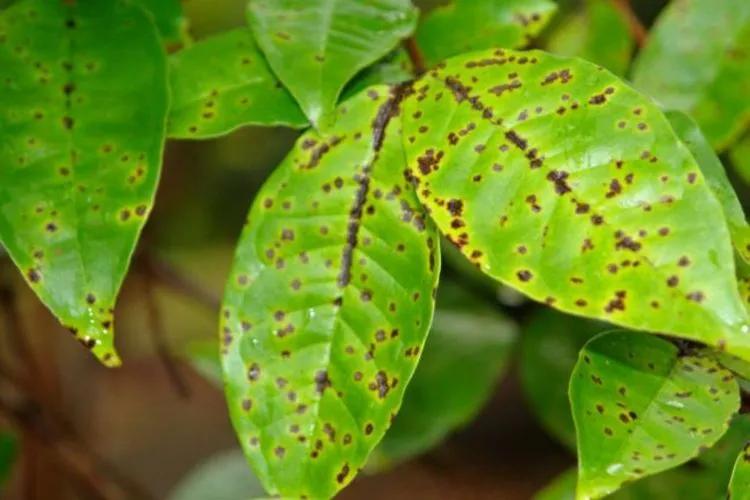
Houseplant rust is a popular disease infecting the pretentious plants (or those with lack of proper care). Here, we analyze the causes of its occurrence, methods of combating, and preventing this disease.
Disease and pathogens
Rust is a fungal disease characterized by rusty stains. In most cases, it strikes wild flowers; however, the domestic can suffer too.
The disease itself is caused by rust fungi: obligate parasites that live in anaerobic conditions. At different times of the year, they go through different phases of development. In winter, this fungus is absolutely not dangerous for the plant, but the rest of the time it is capable of infecting large areas of plants.
Causes
The main reason is the spores getting into the apartment and the weakened immunity of the flowers themselves. What can aggravate the development of rust?
- Lack of drainage. Without a proper drainage system, water stagnates in the soil, oxygen and nutrients are poorly supplied. Thus, the ideal fungus environment develops.
- Lack of sun. Rust loves to appear in dark environments, so a small amount of sunlight contributes to its reproduction.
- Ignorance of diseases. If your flower has already suffered from an infection, and you ignored the affected parts, then the rust will attack them much faster.
- Pests. Needless to say :)
- Nitrogen fertilizing. If you overfeed your plant with nitrogen, this will help fungus to spread.
- Overmoistening of the soil. Any fungi loves moisture and rusty ones are no exception. Excess moisture can happen due to frequent watering or poor drainage.
- Potassium deficiency. Potassium stimulates photosynthesis and metabolism. If there is not enough, these processes are disrupted. Therefore, the plant develops higher exposure to diseases.
- Non-compliance with the rest regime. In winter, most plants go into a dormant state, they do not need frequent watering and mineral fertilizing. If you do not observe the rest conditions for a plant, fill the flower with water and dressings, while putting it on the battery, you should not be surprised at the appearance of rust.
External signs

Rust is a fairly recognizable disease in its appearance. Initially, orange-brown spots appear on the leaves or under them. Over time, these spots increase in size, affecting a large area of living tissue. Move on to buds, shoots, seed pods and stems.
On the leaves affected by rust, light yellow convex spots form, which turn black over time. In these pustules, the process of mycelium, the causative agent of the disease, takes place. After ripening, the walls burst and a rusty powder spills out of them - spores. Then they are carried by the wind, insects, thereby infecting new plants.
In the tissues affected by this infection, metabolism is disturbed, the supply of moisture deteriorates, and the processes of photosynthesis are disrupted. The leaves eventually fall off altogether, and tthe plant may die. Sometimes even the treatment does not help to save the pets. Remember: this disease is easier to prevent than to treat.
Risk group
As mentioned above, this fungus affects the weakest plants. Still, some flowers are more sensitive to fungal spores and simply cannot fight them. Here are the most common ones:
- Rose.
- Geranium.
- Camellia.
- Fuchsia.
- Carnation.
- Pelargonium.
Treatment methods
If you notice rusty spots on the sheets, remove them immediately. To combat pustules, special preparations for spraying flowers will help:
1.When rust is in the early stages and for preventive purposes, we recommend using a 1% solution of copper sulfate.
2. For 5 liters of water add to the solution: 25 grams of soda ash and 5 grams of liquid soap. Be careful when spraying: don’t touch the flowers, they may leave stains.
3. This solution is the safest and most gentle of all. Add 300 grams of wood ash to a small amount of water, then bring this mixture to a boil, after cooling, strain thoroughly. Next, pour the strained solution into 5 liters of water. It is best to spray the plant every 10-12 days.
4. For 1 liter of water, mix a teaspoon of liquid soap, a tablespoon of baking soda and vegetable oil, 1 tablet of crushed aspirin. Process 2 times a month.
5. Bordeaux blend is the most effective option. After the procedure, copper particles remain on the leaves, providing them with a healing and protective effect.
6.Fungicides. If all of the above did not improve the situation, then only fungicides can help. These are some of the most effective in the fight against rust: Coronet, Falcon, Oxyhome and Flint Star.
Prevention
- Maintain correct and regular care of your plants. Water your green pets regularly and correctly, watch for drainage and properly selected dressings, trim off infected parts.
- Treat plants and soil with fungicides as a preventive measure.
- Grow fungal resistant hybrids.
- Remove a sick plant from the rest and ventilate the room often.
FAQ
How Do I Prevent Rust From Recurring in My Garden?
Keep rust from coming back by removing infected leaves as soon as you spot them and keeping the area around plants clean. Water at the soil level so foliage stays dry, and space plants so air can move freely.
